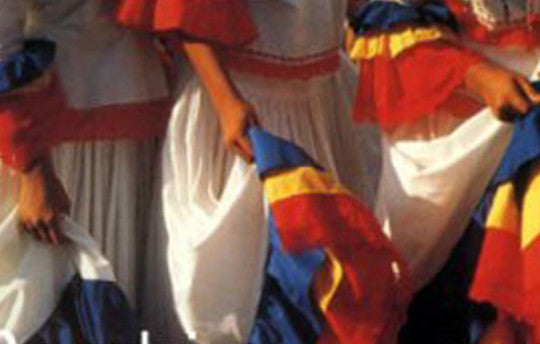Your Cart is Empty

Colombia is one of the powerhouses of Latin music. It plays a major role in the salsa world and is famous for its national music, cumbia.
If one genre stands out as ‘Colombian’, then it is cumbia—a mix of layered rhythms and syncopated melody. Traditional ensembles consist of percussion and vocals. Some folkloric groups still play cumbia using a drum choir of deep bombo, tambor macho and tambor hembra. La Momposina and her troupe are dedicated to preserving, researching and teaching the quickly disappearing roots cumbia.
By the 1940s, cumbia became an urban dance with a loping beat. Lucho Bermudez was one of the first to start updating the sound.
The Cuban music heard on radio and recordings influenced cumbia, contributing to its ‘Golden Age’ in the 1950s and 1960s. One of the best orchestras appeared in the early 1960s, Peregoyo y su Combo Vacana. La Sonora Dinamita was also popular in the 1960s. Their first singer, Melida Yara Yanguma, now heads her own group, La Sonora Meliyara which has successfully updated cumbia further. Yet another 1960s group, Los Corraleros de Majagual, forged a middle way between cumbia and vallenato.
From the 1970s, newly introduced salsa music influenced cumbia, adding salsa sections and rhythms. Cumbia remains a developing style.
 In the late 1960s cumbia was reborn psychedelic. This surf guitar groove sprang from the coastal cities of Colombia, Peru and Mexico where, under the influence of the western psychedelic culture, conditions were ripe for incredible experimentation.
In the late 1960s cumbia was reborn psychedelic. This surf guitar groove sprang from the coastal cities of Colombia, Peru and Mexico where, under the influence of the western psychedelic culture, conditions were ripe for incredible experimentation.
The accordion-led music called vallenato originated on the Atlantic coast and is a national music second only to cumbia. It often uses cumbia rhythms and there is a great deal of cross-fertilisation between the two. In its simplest form an ensemble consists of accordion, guacharaca scraper and the vallenato box. Most contemporary bands add an electric bass and extra percussion. Bass is one of the great glories of modern vallenato. It was introduced in the mid-1960s and is rhythmically freer than the functional bass of cumbia.
Among the best vallenato musicians are Lisandro Meza, Alfredo Gutierrez, and Calixto Ochoa. In 1993 Carlos Vives’ album Clasicos de la Provincia helped change vallenato into modern pop music.
Cuban influence was present for a while, but it wasn’t until salsa in the 1970s that wholesale imitation of a foreign model occurred. Early Colombian salsa was often dark and in predominantly minor keys.
The biggest figure was Joe Arroyo, who invented musica tropical, a salsa based music that incorporates the native rhythms of the coast. Colombia has a more straightforward salsa style, as demonstrated by Grupo Niche, Orquesta Guayacan and Le Misma Gente.
Representatives of a lively rural tradition that has contributed to cumbia are the porros, village fiesta bands. Porros are normally brass bands with a three-man rhythm section of bass and snare drums and cymbals. Most porros have only a local reputation, but a few have achieved wider renown including Banda de 11 Enero.
The music from the vast plains of Colombia is called musica llanera. It is rhythmic and bouncy. Ensembles are lead by a harp, which is supported by a small group from the guitar family: the cuatro and bandolin. One of the earliest recorded llanera singers was Luis Ariel Rey. Other names include Carlos Rojas, Orlando Valdemarra, and Cimarron.
Music of the Colombian Andes is referred to as musica de la interior. A typical group is a trio of tiple, bandola, and guitar and attention is give to melodic complexity. It was thought of as the ‘national’ music par excellence until cumbia took its place. The Morales Pino Trio are the finest representatives, though younger groups have recently increased.
Colombian music reflects an intermingling of peoples, though there are some styles that exhibit a strong African ancestry. On the Pacific coast, African music survives close to its original form. Most music is connected to religious cults and rites.
Another specifically black music is champeta. It draws chiefly on African soukous, and Caribbean styles. Bands include Boogaloo, El Pupy, Elio Boom, and Luis Towersare.